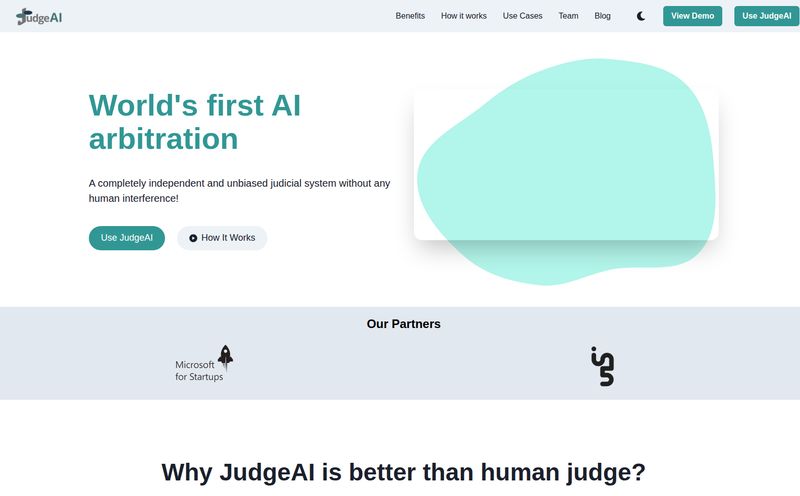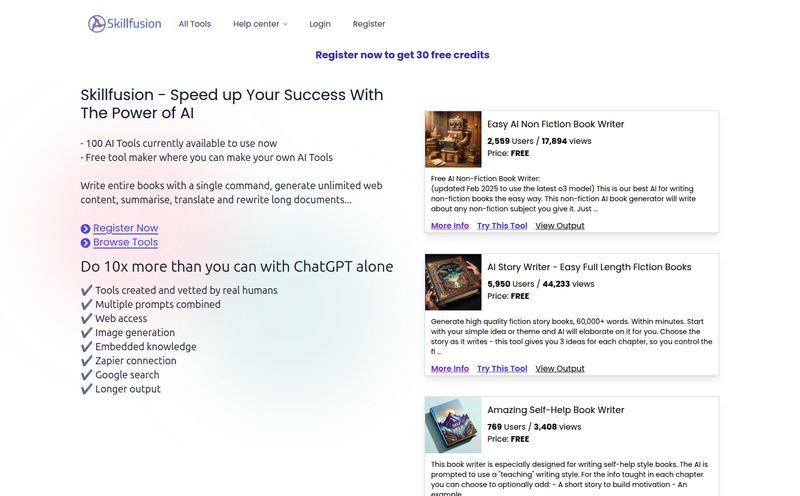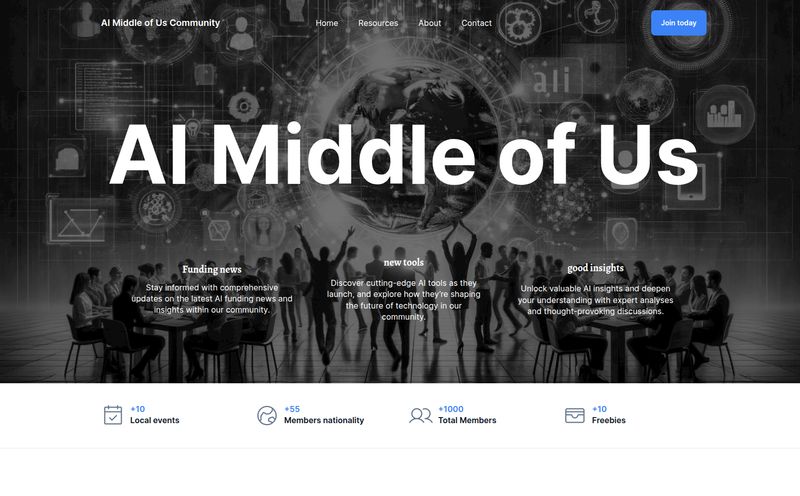There are few things in professional life more tedious than staring at a mountain of documents—financial reports, market research, endless PDFs—knowing the one tiny data point you need is buried somewhere in there. It’s a digital needle in a data haystack. For years, this has been the grunt work we all just accepted. You grab a coffee, put on your headphones, and prepare to lose a few hours of your life to the CTRL+F gods. It’s a rite of passage, right?
Well, maybe not anymore. I’ve been playing around with a tool called Insight Document, and it feels a bit like someone handed me a giant, data-seeking magnet. The whole premise is to use AI, specifically the Large Language Models (LLMs) everyone’s talking about, to do that grunt work for you. And not just find things, but understand and summarize them. I was skeptical, as I always am with new tools promising to revolutionize my workflow, but I have to say… I’m intrigued.
So, let's pull back the curtain on this thing. Is it just another piece of AI hype, or is it a genuinely useful tool that can save you time and, let's be real, a lot of headaches?
What Is Insight Document Anyway?
In the simplest terms, Insight Document is an AI platform that you can feed your documents and databases. Think of it like a super-smart research assistant who can read a 300-page report in seconds and then sit down for a Q&A session. You don't need to know code, you don’t need to build complex queries. You just… ask questions. In plain English.
It wraps powerful AI models around your private data, creating a secure space where you can interrogate your information. You can ask, “What were our top-selling products in Q3 according to this sales report?” or “Summarize the key findings from this research paper in five bullet points.” And it just… does it. This is a far cry from the old way of doing things, and for people who aren't data scientists, it’s incredibly empowering.
The Standout Features That Caught My Eye
A feature list is just a list until you see how it applies to real work. Here’s what stood out to me as actually being useful.
From Document Chaos to Clear Conversation
The core of the platform is its Document Chat. You upload a document (or a whole batch of them), and a chat window pops up. It feels a lot like using ChatGPT, but the AI’s entire world is the information you just gave it. This is huge. I tested it with a few dense industry reports I'd been meaning to read, and I could pull out statistics and expert opinions in minutes instead of hours. It's not just about finding keywords; it’s about contextual understanding. That’s the aha! moment right there.
More Than Just Words: Visuals and Reports
Okay, so a Q&A bot is cool. But what really impressed me was the platform's ability to generate interactive visualizations and reports. You can ask it to “create a bar chart showing revenue growth over the last year,” and it will build one for you. This turns it from a simple analysis tool into a full-blown business intelligence platform. You can assemble these charts and summaries into dashboards that update automatically as you add new data. For a marketing guy like me, being able to spin up a campaign performance dashboard without hassling a data analyst is an insane time-saver.

Visit Insight Document
The Nerdy Stuff That Actually Matters
Digging a little deeper, there are a few advanced features that are worth mentioning. The Knowledge Graph, for example, doesn't just see your documents as separate files; it connects the dots between them. It can find mentions of the same person, company, or concept across different reports to build a more holistic picture. Then there's Web Search Augmentation, which allows the AI to pull in current information from the web to supplement the data in your documents. Finally, for the developers in the room, the full API Integration means you can plug this analytical power into your own custom applications. That's where things get really interesting for larger companies.
The Good, The Bad, and The Pricey
Alright, let's get down to brass tacks. I genuinely like a lot about this tool. The ability to automate report generation is a massive win. It makes data analysis accessible to people who don't live in spreadsheets. For teams in fields like medicine or law, where documentation is heavy, I can see this significantly cutting down on administrative time. The immediate nature of it—getting insights now instead of next week—is its strongest selling point.
But it's not perfect. For one, you're placing a lot of trust in the AI's accuracy. In my experience, you still need to do some validation, especially for critical data. Don't just copy-paste a number into a board presentation without double-checking it. Some of the more advanced features also have a bit of a learning curve. And then there's the elephant in the room: the price. While there's a free tier, the more powerful features are locked behind a subscription that might be a bit steep for solo users or small startups.
A Breakdown of the Pricing Tiers
Speaking of price, let's lay it all out. The structure is tiered, which is pretty standard for SaaS platforms. I’ve always felt that a good free plan is a sign of confidence from a company, and theirs is quite decent for testing the waters.
| Plan | Annual Price | Key Features | Best For |
|---|---|---|---|
| Free | $0 | 4 documents, 5 reports/month, 1 dashboard | Students, freelancers, or anyone wanting to test the platform. |
| Pro Business | $290 | 20 documents, unlimited reports, 10 dashboards, all AI models | Small teams, consultants, and marketing agencies. |
| Pro Advanced | $490 | 50 documents, custom templates, 25 dashboards, priority support | Growing businesses and research-heavy departments. |
| Enterprise Standard | $990 | Unlimited docs (500GB total), API access, custom branding, SLA | Large organizations with heavy data and integration needs. |
Note: This pricing is based on information available at the time of writing. Always check the official Insight Document pricing page for the most current details.
So, Who Should Actually Use Insight Document?
This isn't a tool for everyone. If your daily tasks involve more creative writing than data interpretation, this is probably overkill—like using a sledgehammer to crack a nut. But if you're in a role where you constantly have to answer questions based on a body of documents, this could be a game-changer.
I’m thinking of a few people who would love this:
- Marketing Managers: Instantly analyze campaign reports, survey results, and customer feedback without waiting for the data team.
- Legal Professionals: Quickly search and cross-reference thousands of pages of case law or discovery documents.
- Financial Analysts: Speed up the process of reviewing quarterly earnings reports, prospectuses, and market analysis.
- Academic Researchers: Summarize and find connections within a library of scientific papers and studies.
If you find yourself spending more than a few hours a week just trying to find information, you owe it to yourself to at least try teh free plan.
My Final Take
Look, the world is moving in this direction. AI isn't just a parlor trick anymore; it's becoming a legitimate assistant. Insight Document is a strong example of this shift. It takes the painful, time-consuming process of document analysis and turns it into a simple conversation.
While you need to keep a critical eye on the output and the price tag isn't trivial, the value proposition is clear: it gives you back your time. And in any business, time is the one resource you can never get more of. It democratizes data, letting anyone on the team get the answers they need to make smarter decisions. And for that reason alone, it's a tool I'll be keeping a very close eye on.
Frequently Asked Questions
Is Insight Document secure for sensitive information?
For any tool handling proprietary data, security is paramount. Insight Document positions itself as a platform for businesses, which implies a focus on security. Enterprise plans typically come with SLAs and enhanced security features. However, you should always review their privacy policy and terms of service, and for highly sensitive data, have a direct conversation with their team about their security protocols.
How does this compare to just using a standard AI chat tool?
It's a great question. The main differences are focus and features. A general-purpose AI chat tool is a jack-of-all-trades, but its knowledge is public. Insight Document creates a private, sandboxed environment to analyze your specific documents. Furthermore, it's purpose-built for analysis, with integrated features like report generation, data visualization, and knowledge graphs that you won't find in a standard chatbot.
Do I need to be a data scientist to use it?
Absolutely not, and that's the whole point. It's designed for business users, researchers, and anyone who needs to understand data without having a technical background. That said, having a good understanding of your data and knowing how to ask precise questions will definitely yield better results.
What kind of file types does it support?
It's built to handle common document formats you'd find in any office environment. This generally includes PDF, DOCX, TXT, and likely spreadsheet formats like XLSX. For enterprise users, it also offers direct database connections, allowing it to analyze structured data right from the source.
Can it analyze scanned or handwritten documents?
Typically, tools like this work best with machine-readable text (i.e., text you can copy and paste). While some platforms have Optical Character Recognition (OCR) to convert images of text into readable data, its effectiveness can vary, especially with poor-quality scans or messy handwriting. You'd want to test this with your specific documents on a free or trial plan first.
Reference and Sources
Insight Document Official Website & Pricing: https://www.insightdocument.com/pricing
Gartner, "Top Trends in Data and Analytics for 2023": An article discussing the rise of AI-augmented analytics and how it's changing the business intelligence landscape.



